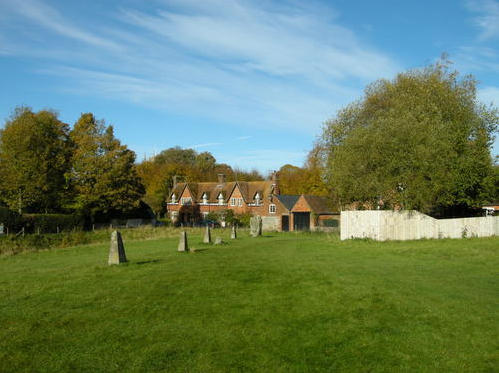Guide 4 – Case Study: Avebury World Heritage site, Wiltshire (United Kingdom)
Baseline situation
Avebury stone circle or ‘henge’ lies at the centre of half the Stonehenge, Avebury, and Associated Sites inscribed as World Heritage. It is the sister-site to the perhaps more widely recognizable monument: Stonehenge. These monuments were inscribed together with their interrelated monuments and wider landscapes due to their common historical narrative. However, Stonehenge is set in the middle of an immediate landscape inhabited only by sheep, whereas Avebury henge is surrounded by the village of Avebury, with homes and roads actually criss-crossing the stone circle. This proximity to a residential area creates a very particular set of management issues, and taking into account the needs of the local community is essential to the sustainable management of the site.
At Avebury challenges stemmed from the tensions between the residents and the numbers people visiting the site. There are peaks at particular times of year from certain special interest groups; a problem that was not specifically addressed by the community until 2006, approximately 20 years after Avebury was inscribed on the World Heritage List.
What did they do?
A feeling of ‘disconnect’ between residents and the World Heritage site and a lack of ownership was identified as a key issue at Avebury by the World Heritage site coordinator. There was also some lack of understanding between different groups who valued the Site for a number of different reasons. The Residents' Pack project set out to address this issue. At the outset, all residents were invited to participate in an aerial photograph standing in the henge. This marked the start of a two-year effort to collect stories from residents and visitors that focused on the various values Avebury was associated with.
Strategic priorities
- Engage the local community; replace any view of the World Heritage site as constraint or as excluding local residents with an understanding of the opportunity and inclusivity it represents.
- Identify and demonstrate to residents the broad spectrum of values to be found at Avebury.
- Develop a feeling of pride and ‘stewardship’ amongst residents.
- Use the values identified to develop a more appropriate visitor strategy.
What worked?
The Residents' Pack was a limited edition, available only to residents of Avebury, and designed to celebrate the World Heritage site as a unique and special place to live. It included a book, Values and Voices, which compiled pieces of writing from a range of people, including archaeologists, residents, farmers, and pagans, both local and from as far away as Germany and America, expressing their personal and professional views of the World Heritage site. Crucially, the Pack also contained information leaflets from the main organisations involved in the management of Avebury, removing the feeling of bureaucracy and identifying who was responsible for what in a much more transparent way. The Pack also indicated ways in which residents could be more involved in the day-to-day running of the site, primarily through voluntary duties such as tracking traffic and guiding visitor parking.
Parking congestion and visitor etiquette had been two key matters that created some tensions between residents and visitors. This was particularly the case at the busiest times of year, such as Solstice. Avebury, like Stonehenge, attracts contemporary pagans and druids from both the UK and further afield, and these visitors amass specifically around the seasonal Solstices and other pagan festivals. Due to the small size and limited infrastructure at Avebury, there are few places for visitors to stay; the resulting ‘improvisation’, in terms of camping and illegal parking, incited tension between residents and visitors. By presenting both visitors' and residents’ impressions side by side, the Residents' Pack gave equal weighting to everyone in an effort to facilitate understanding and tolerance in both this matter and other areas of the site.
What was tough?
There was a sense of distance implied by the concept of ‘Outstanding Universal Value’, which seemed to put abstract philosophical ideas of historic and academic ‘value’ above the needs and wants of the local community. This may have been exacerbated during the joint inscription process of Stonehenge and Avebury to the World Heritage List in 1986, in which there was minimal local stakeholder or community involvement, leaving a feeling among some that World Heritage status was being imposed upon Avebury, rather than chosen. The sheer diversity amongst stakeholders (e.g. residents; visitors; landowners and farmers; pagans; archaeologists) also made it difficult to define any shared vision.
How did they get buy-in?
The success of the Residents' Pack is believed to primarily stem from the way the publication was ‘allowed to evolve organically’, with contributions being accepted as they came in, along with a wide range of formal and informal consultation platforms to attract contributions. As the common perception of those managing World Heritage was one of rigid bureaucracy, this flexibility and absence of tight deadlines or barriers made people feel that their opinion was truly valued.
What are the results?
Values and Voices includes contributions from a range of people and includes reference to the many different kinds of significance found at Avebury, from its official OUV to its very personal value to those born and raised in the area. Individuals and groups not usually represented on formal management committees, such as druids and business owners, also contributed pieces on their relationship to the site. All the voices are heard side-by-side, with no bias given to any particular narrative. This has helped instil an increased feeling of ownership of the site, and the notion that everyone’s values have been given equal weight alongside the more grand concepts of ‘Outstanding Universal Value’.
This publication – while not relieving all tensions – has made residents more willing to accommodate pagan interests in Avebury. The village continues to work with the National Trust to make areas of land available for camping at peak times of the year, and the Chair of the Parish Council in Avebury now chairs the Avebury World Heritage Site Steering Committee. The Residents’ Pack is a valued possession – only very few copies have ever appeared on Ebay, and those at a price which reflects how greatly the pack and the World Heritage is valued by its residents.
What lessons can others take from this?
The most important message to be taken from Avebury is how important it is to facilitate communication between different stakeholders. When interests in a site are as diverse as those at Avebury, it is vital to create a level of understanding between different interest groups to avoid feelings of alienation or disregard in favour of others. Through this type of communication, it is far more likely people will work together in order to uphold these values.
It is also necessary to recognize the criteria of a site that leads to its inscription may not be felt widely amongst the local community. For this reason, it is even more important to engage with people, find out what they value most about the site, and what they find to be the positives and negatives of inscription. Management must be guided by the needs and values of the local community; otherwise, no management strategy will be sustainable or lead to a sense of guardianship amongst its stakeholders.
Read about the Avebury Residents' Pack and other examples of engagement in the English Heritage Conservation Bulletin People Engaging with Places.



